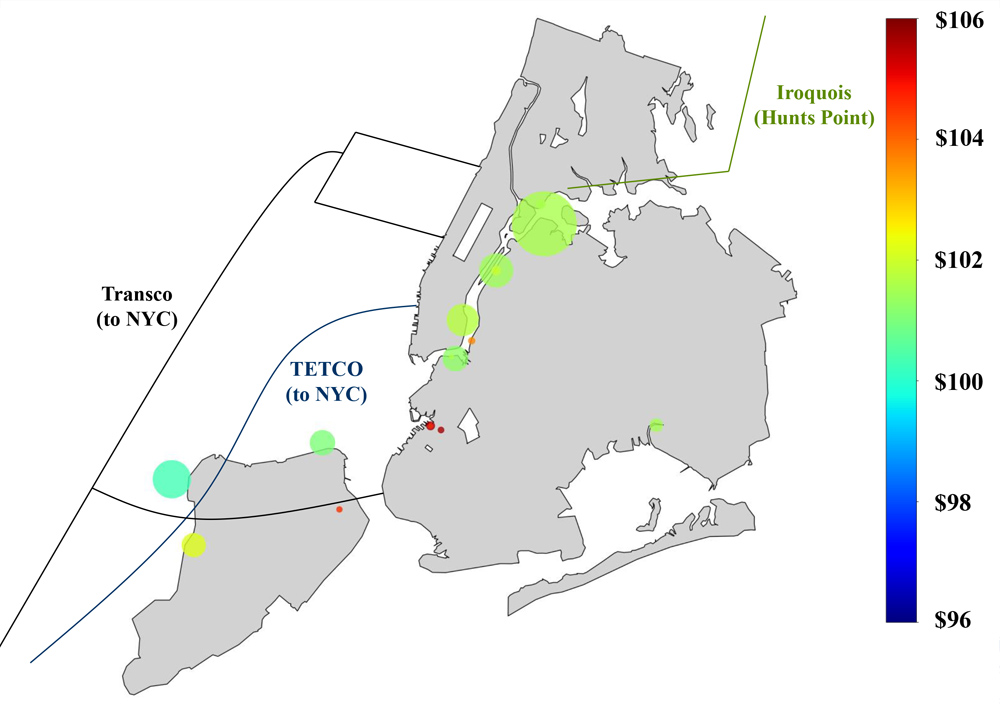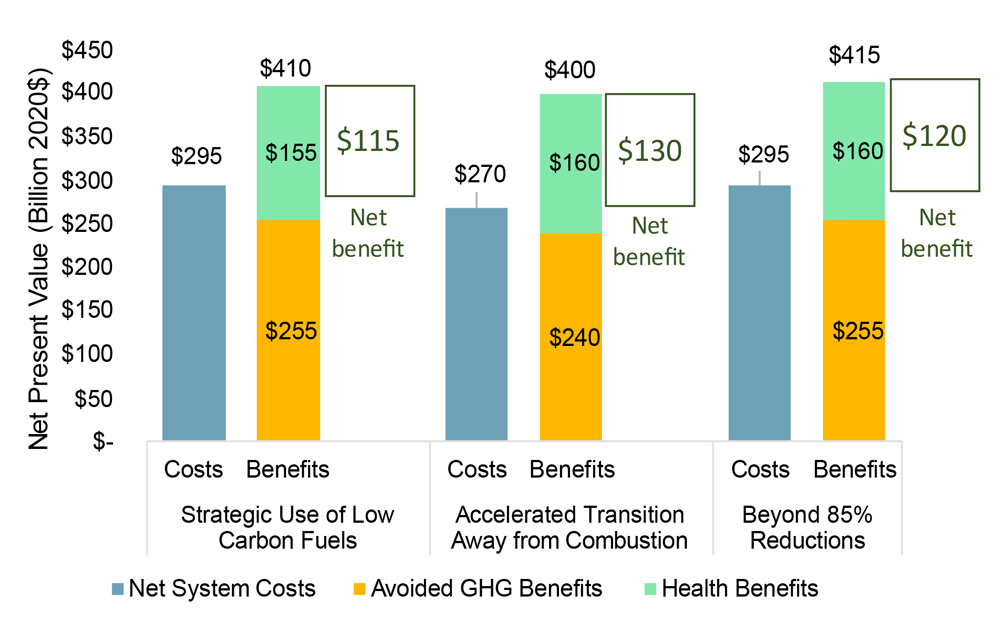ALBANY, N.Y. — New York’s Climate Action Council approved its Scoping Plan for meeting the state’s decarbonization goals Monday, saying the plan will save the state more than $100 billion and create hundreds of thousands of jobs.
But three members of the 22-member council opposed the plan, citing concerns over cost, electric reliability and feasibility.
The scoping plan was mandated by the 2019 Climate Leadership and Community Protection Act (CLCPA), which calls for a 40% cut in economywide greenhouse gas emissions from 1990 levels by 2030 and an 85% cut by 2050. The 445-page plan is the result of more than two years of work by seven sector-specific advisory panels and the Just Transition Working Group and was informed by 11 public hearings and more than 35,000 written comments.
‘Diverse and Divergent’
 Net present value of benefits and costs of three scenarios relative to business-as-usual reference case | New York Climate Action Council
Net present value of benefits and costs of three scenarios relative to business-as-usual reference case | New York Climate Action Council
Council members who supported the plan said that acting on climate change would ultimately be cheaper than inaction.
Paul Shepson, dean of the College of Marine and Atmospheric Sciences at Stony Brook University, said the document is the product of compromise between “diverse and sometimes divergent interests” but is “nonetheless a great statement of New York’s commitment to achieve climate stabilization.”
RuthAnne Visnauskas, CEO of New York State Homes and Community Renewal, said the “process has been exhaustive; it has been comprehensive, thoughtful and inclusive.”
Raya Salter, executive director of the Energy Justice Law & Policy Center, said “true credit belongs with the thousands of protesters who demanded that this be the people’s plan.” She added that more work needs to be done and future advocates should remember to “keep a true north to climate justice.”
Anne Reynolds, executive director for the Alliance of Clean Energy New York, sought to address the “naysayers” in the room, saying that she believed the plan addressed all the concerns raised.
Cost Concerns
Voting against the plan were Dennis Elsenbeck, head of energy and sustainability at law firm Phillips Lytle; Gavin Donohue, CEO of the Independent Power Producers of New York (IPPNY); and Donna L. DeCarolis, president of National Fuel Gas Distribution.
Elsenbeck said the plan “fundamentally missed the economics of sustainability” and was not ensuring that “state investments drive substantial return on [New York’s] economy and environment.”
Donohue said a scoping plan should identify the most cost-effective and technologically feasible path to meeting the state’s climate goals. “This document does not do that. The ramifications of this plan do not just impact the energy sector, they will affect the entire New York State economy. Reliability is paramount and is not adequately addressed,” he said.
 New York greenhouse gas emissions by sector | New York Climate Action Council
New York greenhouse gas emissions by sector | New York Climate Action Council
“We may achieve our 2030 goals if absolutely everything goes as anticipated by the plan,” he added. “Getting from 2030 to 2040 is going to need magic since the pathway and timetable for identifying and developing zero-emission dispatchable resources so that they are operating by 2040, is missing.”
DeCarolis said that the “plan fails to use the existing natural gas system for decarbonization,” and that consumers, particularly those in Northern and Western New York, should be given the option to use existing infrastructure to avoid higher costs.
She said the plan is based on an “undue reliance on electrification” and that, without a quantitative analysis of the economic impacts stemming from forcing consumers to electrify, the CAC cannot say for certain whether “consumers will pay more for a less reliable system.”
Donohue also pointed to consumer impacts from the plan, saying that consumers should not be “fooled because we don’t know what the costs will be,” pointing out that the CAC has not conducted a comprehensive cost or price study.
Both DeCarolis and Donohue also cited concerns about regulation.
Donohue said that there is immense “uncertainty” about how the state will be able to permit all the generation and transmission projects needed. Without “regulating our energy properly,” New York will not be able to stay competitive with other states, he said.
DeCarolis told members that the plan “relies too heavily on energy sources prone to energy disruptions.”
Protecting Disadvantaged Communities, Creating Jobs
The council said plan “prioritizes disadvantaged communities and the creation of good, family-sustaining, union jobs accessible to all New Yorkers.”
The council said it examined several pathways to reducing GHG emissions “governed by foundational principles of ensuring reliability [and] cost-effectiveness.”
The council concluded that:
- Achieving deep decarbonization is feasible by 2050 but will require action in all sectors. “Every sector will see significant transformation over the next decade and beyond, which will require critical investments in New York’s economy.”
- Energy efficiency and end-use electrification are essential. About 1 to 2 million efficient homes must be electrified with heat pumps by 2030 and 3 million zero-emission vehicles (predominantly battery electric) will be needed by 2030.
- The cost of inaction exceeds the cost of action by more than $115 billion. GHG emission-reduction strategies will improve air quality, increase “active transportation,” and energy efficiency investments for low- and moderate-income homes. Reducing emissions also avoids the economic impacts of societal damages from climate change.
- New jobs from Climate Act investments will outnumber displaced jobs by a ratio of 10 to 1 in 2030, with up to 211,000 jobs expected to be created by 2030 and 318,000 by 2040.
- Net direct costs are estimated to be up to 0.6% of New York’s economy in 2030 and 1.3% in 2050. The federal Inflation Reduction Act is expected to reduce the costs of decarbonization.
Chair Comments
NYSERDA President Doreen Harris and Department of Environmental Conservation Commissioner Basil Seggos took questions from reporters after the council meeting concluded.
“The burden now shifts to the agencies, chiefly the DEC, to chart a path forward,” Seggos said, citing the agency’s finalization last week of regulations on handling of air pollution control permit applications and incorporating climate change considerations in all activities.
“What we’ve learned as a council is that there are higher degrees of uncertainty with respect to how we reach our goals,” Harris said. The reason the council will periodically reconvene is because the “truth is that 2050 will be very different than what any one of us can predict, so it is important to keep long term objectives in mind.”
Other Reaction
Advanced Energy Economy applauded the plan.
“New York now has a plan for removing most carbon emissions from the state’s economy, an ambitious and laudable goal that will increase clean energy use, put more New Yorkers to work, and support local economies,” said Angela Kent, policy principal at AEE. “With a decarbonization plan in hand, Gov. [Kathy] Hochul and state leaders should act swiftly to implement the plan’s recommendations, especially in order to make it easier for clean energy projects to connect to the grid, and create new financial incentives for communities to switch to clean energy.”
Anbaric praised the council for supporting transmission upgrades. “With 9 GW of offshore wind power coming online by 2035 — and a recommendation for up to 19 GW of new offshore wind — New York urgently needs a shared and open-access transmission system to ensure offshore wind power is delivered efficiently, affordably and reliably to the highest demand centers,” Mid-Atlantic President at Anbaric Janice Fuller said.

